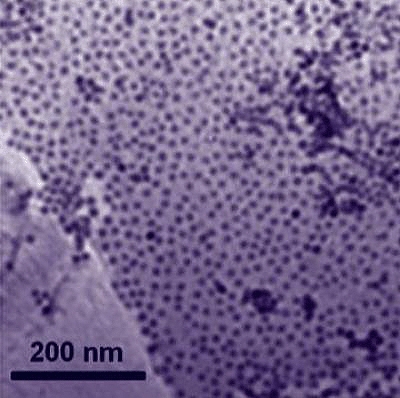Brown University chemist Shouheng Sun and his students said they have developed a new material — a graphene sheet covered by cobalt and cobalt-oxide nanoparticles — that can catalyse the oxygen-reduction reaction nearly as well as platinum can and is substantially more durable.
The new material has the best reduction performance of any non-platinum catalyst, said Shaojun Guo, postdoctoral researcher in Sun’s lab and lead author of a paper published online in the journal Angewandte Chemie International Edition.

The oxygen-reduction reaction occurs on the cathode side of a hydrogen fuel cell. Oxygen functions as an electron sink, stripping electrons from hydrogen fuel at the anode and creating the electrical pull that keeps the current running through electrical devices powered by the cell.
‘The reaction requires a catalyst, and platinum is currently the best one,’ said Sun in a statement. ‘But it’s very expensive and has a very limited supply, and that’s why you don’t see a lot of fuel-cell use aside from a few special purposes.’
So far, scientists have been unable to develop a viable alternative. A few researchers, including Sun and Guo, have developed new catalysts that reduce the amount of platinum required, but an effective catalyst that uses no platinum at all remains challenging.
Lab tests performed by Sun and his team showed that the new graphene-cobalt material was slower than platinum in getting the oxygen reduction reaction started but that once the reaction was going the new material reduced oxygen at a faster pace than platinum.
The new catalyst also proved to be more stable, degrading more slowly than platinum over time. After about 17 hours of testing, the graphene-cobalt catalyst was performing at around 70 per cent of its initial capacity. The platinum catalyst the team tested performed at less than 60 per cent after the same amount of time.
Honeycomb structure
Cobalt is an abundant metal, readily available at a fraction of the cost of platinum. Graphene is a one-atom-thick sheet of carbon atoms arranged in a honeycomb structure. Developed in the last few years, graphene is renowned for its strength, electrical properties and catalytic potential.
Often, graphene nanoparticle materials are made by growing nanoparticles directly on the graphene surface, but that process is problematic for making a catalyst, Sun said. ‘It’s really difficult to control the size, shape and composition of nanoparticles,’ he said.
Sun and his team used a self-assembly method that gave them more control over the material’s properties.
First, they dispersed cobalt nanoparticles and graphene in separate solutions.
The two solutions were then combined and mixed thoroughly using sound waves, causing the nanoparticles to attach evenly to the graphene in a single layer and maximising the potential of each particle to be involved in the reaction.
The material was then pulled out of solution using a centrifuge and dried. When exposed to air, outside layers of atomic cobalt on each nanoparticle are oxidised, forming a shell of cobalt-oxide that helps protect the cobalt core.
The researchers could control the thickness of the cobalt-oxide shell by heating the material at 70ºC for varying amounts of time.
Heating it longer increased the thickness of the shell. This way, they could fine-tune the structure in search of a combination that gave top performance. In this case, they found that a 1nm shell of cobalt-oxide optimised catalytic properties.
Sun and his team are optimistic that with more study their material could one day be a suitable replacement for platinum catalysts.
‘Right now, it’s comparable to platinum in an alkaline medium but it’s not ready for use yet,’ Sun said. ‘We still need to do more tests.’





Nanogenerator consumes CO2 to generate electricity
Whoopee, they've solved how to keep a light on but not a lot else.